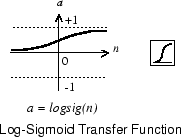logsig
Log-sigmoid transfer function
Description
Tip
To use a logistic sigmoid activation for deep learning, use sigmoidLayer or the
dlarray method
sigmoid.
A = logsig(N)N and returns the
S-by-Q matrix, A, of the elements of
N squashed into [0, 1].

logsig is a transfer function. Transfer functions calculate a layer’s
output from its net input.
info = logsig(code)
Examples
Input Arguments
Output Arguments
Algorithms
logsig(n) = 1 / (1 + exp(-n))
Version History
Introduced before R2006a
